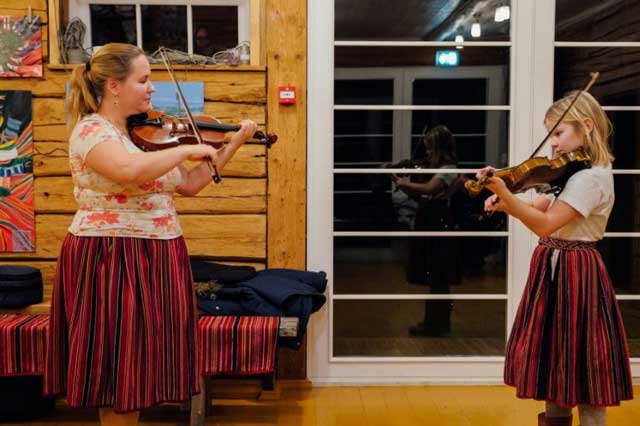
Estonia | AFP | For centuries on a small, forested island in the Baltic Sea, women in headscarves and striped red skirts have done most of the work: from farming to lighthouse keeping, leading church services and even dressing up as Santa at Christmas.
The men of Kihnu island, 10 kilometres (six miles) off the coast of Estonia, are away at sea fishing for weeks or months at a time, leaving the women to run what is often dubbed one of the last matriarchal societies in Europe.
Steeped in folk traditions, Kihnu’s historic way of life however is now threatened as economic hardship drives more and more islanders away in search of work.
“Around every kitchen table, every day, we discuss how to survive,” Mare Matas, official guide and ardent defender of Kihnu’s heritage, tells AFP.
Although 686 people are registered as living on the island, only 300 now do so year-round, says Matas, a 45-year-old mother of four who was instrumental in securing UNESCO recognition of Kihnu’s intangible cultural heritage in 2008.
Since the global economic crash hit Estonia hard that year, the island’s year-round population has halved.
The island of 16 square kilometres (six square miles) has only a few paved roads, two small food shops, a museum, church and primary school with 36 children, down from over 100 some years ago.
Kihnu life still revolves around ancient folk traditions and songs, a unique culture which UNESCO describes as a “masterpiece of oral and intangible heritage of humanity”.
“We are going to lose it if people don’t live here any more,” Matas says. “We don’t know what to do.”
– Sea invaders –
“Seals and cormorants, they’re the biggest problem,” fisherman Margus Laarents tells AFP, as he smokes a batch of recently-caught fish on a griddle behind his house.
The two species were given protected status by the European Union after almost dying out during the middle of the last century due to overhunting.
As a result, their numbers have skyrocketed in Estonian waters since the mid-1980s, depleting local fish stocks.
Other studies have also blamed commercial overfishing and water pollution for the shrinking fish populations.
A 2010 study found that catches of perch had fallen in size ten-fold over a decade, while roach catch sizes were a hundred times smaller.
Margus and his wife Marge say they can no longer live off their earnings from the sea.
Like many on the island, the couple sustain themselves by keeping animals and growing food, although many fishermen have left altogether, in search of construction work in Norway or Finland.
– Men doing women’s jobs –
At their weekly coffee morning, 12 of Kihnu’s older residents exchange news, gossip and memories around a table of salted herring, biscuits and chocolates.
Today’s chat turns to how the men tend to be around on the island much more nowadays, doing jobs which used to be done just by women.
Years ago, recalls 68-year-old Merasse Salme, the sight of her husband Oskar helping out with agricultural work on the island would turn heads.
“Oskar was one of the first men who came to work in the fields,” she said.
“It made us all laugh to see a man working the land,” another chuckled.
But since then, men have increasingly turned away from fishing and it’s no longer rare to see them farming to help support themselves and their families.
Tourism has also become an important source of income for both men and women, but only during the three months of summer.
Up to 30,000 visitors a year — about half from Estonia and many others from Europe or Asia — come to experience Kihnu’s untouched way of life.
With no hotels or restaurants, a number of islanders put up guests in their homes.
Another traditional Kihnu livelihood is weaving clothes and knitting intricately patterned mittens or socks.
But Mare Matas says that selling handicrafts is no longer a profitable way to make a living, given the availability of mass-produced clothing now.
“All those things which were always important are not so important any more,” she says.
– Guardians of culture –
Gender roles may have blurred, but one job still lies squarely with the women: keeping Kihnu’s centuries-old culture alive.
With the men away at sea, tradition dictates that the island’s women must organise Kihnu’s many festivals, as well as funerals and weddings — all elaborate, ancient ceremonies sometimes involving many days of singing, dancing and pre-Christian rituals.
During a Kihnu wedding, the bride’s head is covered with a white cloth edged in red — signifying supernatural protection — until she reaches the house of the groom.
Folk singing and fiddle or accordion playing are indispensible skills for the island’s women and girls, many of whom still wear the traditional red striped Kihnu skirt every day.
Folk singer Virve Koster is Kihnu’s most famous daughter.
Aged 92 but still touring the country performing, Koster is often said to embody the indefatigable spirit of Kihnu’s women.
From her living room decorated with awards and memorabilia, Koster recounts her years of toil in the freezing sea boxing up the herring or ploughing the fields with nothing but woollen socks on her feet.
“Everything has been hard,” she tells AFP.
But she found joy, and fame, through her 400 songs, about island life, nature and, most of all, love.
Koster insists her music belongs to the whole community, a source of unity and hope for the island.
“My songs become more joyful every day,” she laughs.
– ‘New world’ –
Standing at the foot of the 150-year-old lighthouse’s iron spiral staircase, its keeper Elly Karjam says that EU money has helped make life easier.
“The harbour and airport are in order, now they’re fixing the sewer system, there’s an internet connection,” she tells AFP.
However, she worries that Kihnu needs a home for the elderly, given the lack of young people to care for them.
Although many islanders have left Kihnu, some are returning.
Violin teacher Maria Michelson moved back after university, and now schools the island’s children, passing Kihnu’s musical heritage on to them.
She says that the internet, and a new twice-daily ferry to the mainland, have revolutionised life here but wonders where that will leave Kihnu’s traditional way of life.
“This local culture that we have, can it compete with this new world or not?” she says.
“We’ll see.”
 The Independent Uganda: You get the Truth we Pay the Price
The Independent Uganda: You get the Truth we Pay the Price



